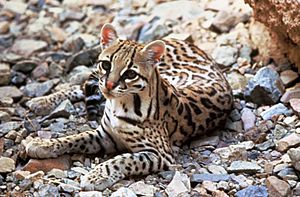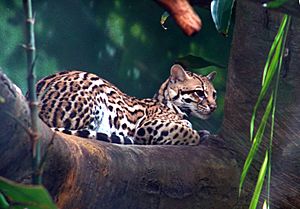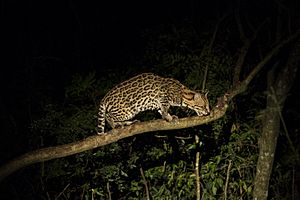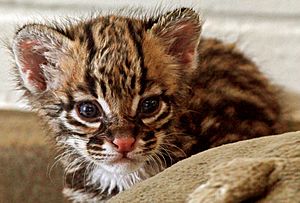Ocelot facts for kids
Quick facts for kids Ocelot |
|
|---|---|
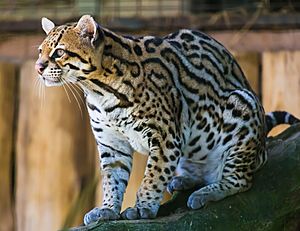 |
|
| An ocelot in a zoo in Brazil | |
| Conservation status | |
| Scientific classification | |
| Genus: |
Leopardus
|
| Species: |
pardalis
|
| Subspecies | |
|
|
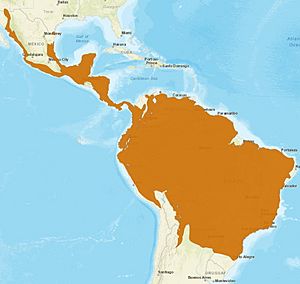 |
|
| Distribution of the ocelot (2016) | |
| Synonyms | |
|
List
Felis aequatorialis (Mearns, 1903)
F. albescens (Pucheran, 1855) F. armillatus (Cuvier, 1820) F. brasiliensis (Schinz, 1844) F. buffoni (Brass, 1911) F. canescens (Swainson, 1838) F. chati (Gray, 1827) F. chibi-gouazou Gray, 1827) F. grifithii (J. B. Fischer, 1829) F. hamiltonii (J. B. Fischer, 1829) F. limitis (Mearns, 1902) F. ludoviciana (Brass, 1911) F. maracaya (Wagner, 1841) F. maripensis (Allen, 1904) F. mearnsi (Allen, 1904 F. melanura (Ball, 1844) F. mexicana (Kerr, 1792) F. mitis (Cuvier, 1820) F. ocelot (Link, 1795) F. pardalis (Linnaeus, 1758) F. pseudopardalis (Boitard, 1842) F. sanctaemartae (Allen, 1904) F. smithii (Swainson, 1838) Leopardus griseus Gray, 1842 L. pictus Gray, 1842 |
|
The ocelot (Leopardus pardalis) is a beautiful, medium-sized wild cat with spotted fur. It stands about 40–50 cm (15.7–19.7 in) tall at the shoulder. These cats usually weigh between 7 and 15.5 kg (15.4 and 34.2 lb).
Ocelots live in the southwestern United States, Mexico, Central and South America. They are also found on the Caribbean islands of Trinidad and Margarita. Carl Linnaeus first described the ocelot scientifically in 1758. There are two recognized types, or subspecies, of ocelots.
Ocelots are great at climbing, jumping, and swimming. They like to live near water in places with lots of plants and plenty of prey. They mostly hunt small animals like armadillos, opossums, and rabbits. Ocelots are usually active during the evening and at night. They tend to live alone and protect their territory.
Both male and female ocelots can start having babies when they are about two years old. They can breed all year round, but the busiest mating times change depending on where they live. After being pregnant for two to three months, the female gives birth to one to three kittens. The young stay with their mother for up to two years. After that, they leave to find their own home ranges.
The ocelot is listed as "Least Concern" by the IUCN Red List. This means they are not currently in great danger of disappearing. However, they are still threatened by habitat destruction, hunting, and traffic accidents. Even though they live in a very large area, their numbers are going down in many places. People have known about ocelots for a long time, even back to the Aztec and Incan times. Sometimes, they have even been kept as pets.
Contents
What's in a Name?
The name "ocelot" comes from the Nahuatl word ōcēlōtl. This word usually referred to the jaguar, not the ocelot. Another idea is that the name comes from the Latin word ocellatus. This means "having little eyes" or "marked with eye-like spots." This makes sense because of the ocelot's spotted fur.
Ocelots have many other names depending on the country. For example, they are called cunaguaro in Venezuela and jaguatirica in Brazil. In Costa Rica, they are known as manigordo.
What Do Ocelots Look Like?
An ocelot's fur has many solid black markings. These markings are on a background that can be creamy, yellowish, reddish gray, or just gray. The spots on their head and legs are small. But the markings on their back, cheeks, and sides are larger stripes or bands. A few dark stripes run from the back of their neck to the tip of their tail.
Their neck and belly are white. The inside of their legs has a few horizontal stripes. Their round ears have a bright white spot. Ocelot fur is short, about 0.8 cm (0.3 in) long on the belly. The longer guard hairs on their back are about 1 cm (0.4 in) long. Each ocelot has a unique fur pattern, just like human fingerprints. This helps scientists tell them apart. Their eyes are brown, but they glow golden when light shines on them.
Ocelots are the largest members of the Leopardus cat family. Their body length is from 55 to 100 cm (21.7 to 39.4 in). Their tail is 30 to 45 cm (11.8 to 17.7 in) long. They usually stand 40–50 cm (15.7–19.7 in) tall at the shoulder. Female ocelots weigh between 7 and 12 kg (15 and 26 lb). Males are a bit heavier, weighing between 8 and 18 kg (17.6 and 39.7 lb).
Ocelots can sometimes be confused with the margay and the oncilla. However, ocelots are much bigger and heavier. They also have a shorter tail. All three cats have rosettes (rose-like patterns) on their coats. But the ocelot usually has a more blotchy pattern. The oncilla has dark spots on its belly, which the other two do not. There are also differences in their faces, tails, and fur.
Where Do Ocelots Live?
Ocelots live from the southwestern United States all the way to northern Argentina. They can be found up to 3,000 m (9,800 ft) high in the mountains. In the United States, you can find them in Texas and Arizona. They used to live in Louisiana and Arkansas but are no longer there.
Ocelots live in many different places. These include tropical forests, thorny forests, mangrove swamps, and savannas. They prefer areas with lots of prey and water. They also like places with thick forest cover. They try to stay away from roads and human towns. They avoid steep hills and very high areas because there isn't enough food there. Ocelots can adapt well to their surroundings.
They often share their homes with other big cats. These include jaguars, jaguarundi, margays, oncillas, and cougars.
Ocelot Behavior and Daily Life
Ocelots usually live alone. They are most active during the evening and at night. During the day, they rest in trees or in dens under large trees. They also find other cool, safe spots on the ground.
They are very good at climbing and jumping. They can escape from danger by leaping into trees. Ocelots are also strong swimmers. They mark their territory by spraying urine. Male territories are quite large, from 3.5–46 km2 (1.4–17.8 sq mi). Female territories are smaller, from 0.8–15 km2 (0.3–5.8 sq mi). A male's territory often overlaps with two or three females' territories. Females usually don't share their territories with other females.
Ocelots don't interact much with each other unless they are mating. However, sometimes adults are seen together even when not breeding. Young ocelots might interact with their parents. Ocelots can be very aggressive when defending their territory. They might even fight to the death.
Ocelots often leave their droppings in special shared spots called latrines. This is a way for them to communicate with other ocelots.
Hunting and Diet
Ocelots are clever hunters. They have been seen following scent trails to find their prey. They walk slowly, about 0.3 km/h (0.2 mph), while looking for food. Sometimes, an ocelot will wait for prey for 30 to 60 minutes in one spot. If nothing shows up, it moves to another spot, walking a bit faster at 0.8–1.4 km/h (0.5–0.9 mph).
Ocelots prefer to hunt in areas with lots of plants for cover. They avoid open spaces, especially on moonlit nights. This helps them stay hidden from their prey. As carnivores, they eat small land mammals. These include rodents, rabbits, armadillos, and opossums. They also eat fish, crabs, insects, reptiles, and birds. They usually eat their prey right away. But they will remove bird feathers first.
Ocelots mostly hunt animals that weigh less than 1 kg (2.2 lb). They rarely go after large animals like deer or peccaries. They need about 600–800 g (21–28 oz) of food every day to stay healthy.
What ocelots eat can change with the seasons. In Venezuela, they prefer iguanas and rodents in the dry season. But they switch to land crabs in the wet season.
Reproduction and Life Cycle
During mating season, both male and female ocelots make a loud "yowl" sound. They also make a softer "meow" sound when they are closer. Ocelots can mate at any time of the year.
After being pregnant for two to three months, a female ocelot gives birth to one to three kittens. She usually has her babies in dens hidden in thick plants. A newborn kitten weighs about 200–340 g (7.1–12.0 oz). Kittens are born with spots and stripes, but on a gray background. Their fur changes to a golden color as they grow older.
A mother ocelot keeps her kittens in a den for 13 to 64 days. She might move them to two or three different dens. The kittens' eyes open about 15 to 18 days after they are born. They start to leave the den when they are about three months old. They stay with their mother for up to two years. Then, they leave to find their own territories. Compared to other cats, ocelots have fewer babies at a time. They also have a longer time between births. Ocelots in zoos can live for up to 20 years.
Threats to Ocelots
Ocelots face dangers throughout their range. One big threat is the loss and breaking up of their homes. In Texas, for example, land that ocelots need is being used for farming. Their habitat gets broken into small pieces. These small areas can't support many ocelots, which can lead to them starving.
Traffic accidents are also a major threat. Ocelots try to move to new areas and sometimes get hit by cars. In the Atlantic Forest in Argentina, logging and poaching (illegal hunting) of the animals they eat also hurt ocelot populations.
The fur trade was a huge problem in the 1960s and 1970s. Many ocelots were hunted for their skins. In 1970, about 140,000 ocelot skins were sold. After that, many countries banned the trade of spotted cat skins. This caused the number of ocelot skins being sold to drop. In 1989, the ocelot was added to Appendix I of the Convention on International Trade in Endangered Species. This means it's illegal to trade them internationally. However, illegal hunting for skins still happens and is a big danger.
Another threat is the international pet trade. Even though it's banned in many places, some people still buy and sell ocelots as pets. In some parts of Central and South America, you can still find them for sale in local markets.
Protecting Ocelots
The ocelot is listed as "Least Concern" on the IUCN Red List. This is because they are found across a wide area in the Americas. Hunting ocelots is now banned in many countries. These include Argentina, Brazil, Mexico, and the United States. In Peru, hunting is controlled.
As of 2013, there were estimated to be more than 40,000 adult ocelots in the world. Their numbers were stable in some parts of the Amazon basin. In Texas, however, the ocelot population has dropped a lot. As of 2014, there were only about 50–80 ocelots left in Texas. This small number leads to inbreeding and less variety in their genes.
Organizations like the US Fish and Wildlife Service and the Texas Parks and Wildlife Department are working to protect ocelots. They are helping to save and regrow the plants in the Lower Rio Grande Valley that ocelots need.
Ocelots in Zoos
The American Zoo and Aquarium Association has a special plan to help ocelots in zoos. This plan helps make sure that ocelots in zoos are healthy and can have babies. In 2006, there were 16 ocelots in North American zoos. Some of these babies were born using special methods like artificial insemination. Zoos like the Emperor Valley Zoo in Trinidad also care for ocelots that have been rescued or caught.
Ocelots in Culture
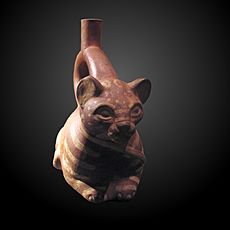
Ocelots have been important to people for a very long time. The Aztec and Incan people showed ocelots in their art and stories. You can see ocelots in their pottery, paintings, and even buildings. Ocelot bones were sometimes used to make tools for special ceremonies.
Some old stories connect the ocelot to important gods. For example, the Aztec god Tezcatlipoca was sometimes shown as an ocelot.
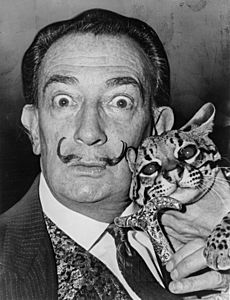
Like many other wild cats, ocelots have sometimes been kept as pets. However, they can be a lot of work. They need a lot of attention and might chew on things. They can also accidentally hurt their owners because they are very playful and agile. But if they are raised carefully, they can be very loving.
The famous painter Salvador Dalí had a pet ocelot named Babou. He often took Babou with him when he traveled. Once, when someone in a restaurant was scared of his ocelot, Dalí joked that it was just a regular house cat he had "painted over." Other famous people, like opera singer Lily Pons, also had pet ocelots.
Images for kids
See also
 In Spanish: Ocelote para niños
In Spanish: Ocelote para niños



